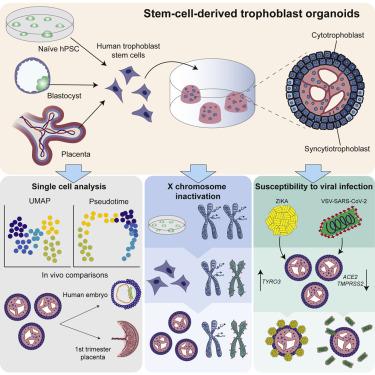Cell Stem Cell ( IF 19.8 ) Pub Date : 2022-05-05 , DOI: 10.1016/j.stem.2022.04.004 Rowan M Karvas 1 , Shafqat A Khan 1 , Sonam Verma 2 , Yan Yin 3 , Devesha Kulkarni 4 , Chen Dong 1 , Kyoung-Mi Park 1 , Brian Chew 1 , Eshan Sane 1 , Laura A Fischer 1 , Deepak Kumar 2 , Liang Ma 3 , Adrianus C M Boon 5 , Sabine Dietmann 6 , Indira U Mysorekar 7 , Thorold W Theunissen 1

|
Trophoblast organoids derived from placental villi provide a 3D model system of human placental development, but access to first-trimester tissues is limited. Here, we report that trophoblast stem cells isolated from naive human pluripotent stem cells (hPSCs) can efficiently self-organize into 3D stem-cell-derived trophoblast organoids (SC-TOs) with a villous architecture similar to primary trophoblast organoids. Single-cell transcriptome analysis reveals the presence of distinct cytotrophoblast and syncytiotrophoblast clusters and a small cluster of extravillous trophoblasts, which closely correspond to trophoblast identities in the post-implantation embryo. These organoid cultures display clonal X chromosome inactivation patterns previously described in the human placenta. We further demonstrate that SC-TOs exhibit selective vulnerability to emerging pathogens (SARS-CoV-2 and Zika virus), which correlates with expression levels of their respective entry factors. The generation of trophoblast organoids from naive hPSCs provides an accessible 3D model system of the developing placenta and its susceptibility to emerging pathogens.
中文翻译:

干细胞衍生的滋养层类器官模拟人类胎盘发育和对新出现病原体的易感性
源自胎盘绒毛的滋养层类器官提供了人类胎盘发育的 3D 模型系统,但获得妊娠早期组织的机会有限。在这里,我们报告从初始人类多能干细胞(hPSC)中分离的滋养层干细胞可以有效地自组织成3D干细胞衍生的滋养层类器官(SC-TO),其具有与原代滋养层类器官相似的绒毛状结构。单细胞转录组分析揭示了不同的细胞滋养层和合体滋养层簇以及一小簇绒毛外滋养层的存在,它们与植入后胚胎中的滋养层身份密切对应。这些类器官培养物显示出先前在人类胎盘中描述的克隆 X 染色体失活模式。我们进一步证明 SC-TO 对新兴病原体(SARS-CoV-2 和寨卡病毒)表现出选择性脆弱性,这与其各自进入因子的表达水平相关。从初始 hPSC 生成滋养层类器官,为发育中的胎盘及其对新兴病原体的易感性提供了一个可访问的 3D 模型系统。











































 京公网安备 11010802027423号
京公网安备 11010802027423号